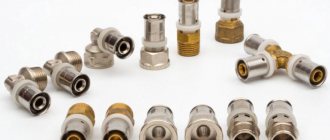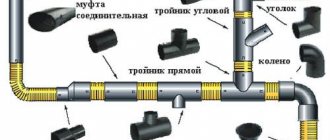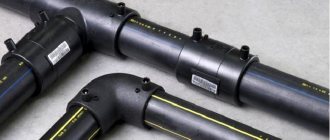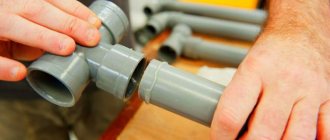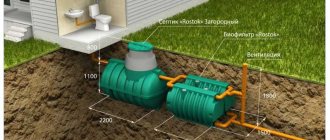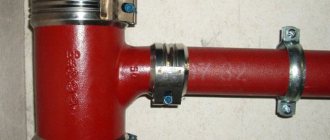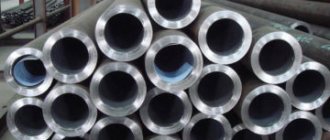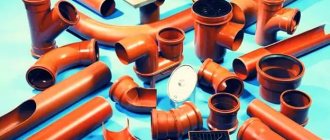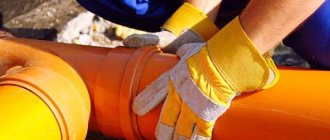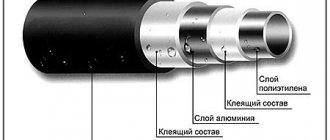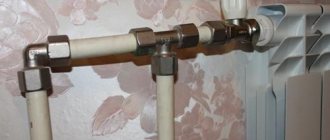Glue for PVC pipes speeds up the pipeline assembly process and reduces costs. It is made from polyvinyl chloride, with the addition of additives that increase adhesion. Installation does not require special skills, a welding machine or additional parts. It is advisable to use compounds recommended by the manufacturer of specific pipes.
Areas of use
The scope of application of adhesive PVC pipelines depends on their physical and chemical characteristics; the products are used for the installation of communications in the following areas:
- Construction of swimming pools. Adhesive PVC pipes are widely used in the construction of water supply and purification systems in swimming pools. Due to the tightness of the joints and the high anti-corrosion characteristics that polyvinyl chloride has, such pipes are most suitable when working with chlorinated water.
- Air conditioning, cooling systems. PVC adhesive pipes are suitable for transporting liquid low-temperature and aggressive substances, such as refrigerant, chlorine, and so on during the construction of industrial air conditioning units, chillers, coolers.
- Laying pressure sewer. The average consumer is well aware of the sewerage system that is installed in apartments and country houses. It is assembled using the socket method, inserting pipes into each other, while sealing is ensured by internal rubber rings mounted in the expanded pipes. This type of installation does not withstand high pressure of the liquid working medium, which cannot be said about the sewer line assembled by gluing. Most often, adhesive sewer PVC pipes are laid in swimming pools and water parks to move large volumes of water at high speed.
- Water purification and preparation systems. Due to the resistance of polyvinyl chloride to solutions with a high percentage of various types and concentrated sulfuric acids, sodium hypochlorite, demineralized and deionized water, PVC pipes are widely used in the workshops of water treatment plants.
- Chemical industry. Glued PVC pipelines are installed at chemical plants to transport aggressive liquids - mineral acids, alkalis, solutions of salts, oils, fats, gasoline without the presence of benzene.
Rice. 2 Examples of using glued PVC pipes
- Agriculture. Glued PVC pipes are used to assemble greenhouse piping - drip irrigation systems, pipeline units for supplying solutions with fertilizers. In livestock farming, polyvinyl chloride is used to assemble engineering structures for the delivery of feed and drinking water, and manure removal.
- Cold and hot water supply systems. Almost all adhesive PVC pipes and fittings are designed for use in temperatures up to +60 °C, so they are used to supply cold water. In pipelines with a high-temperature working environment, pipelines made of chlorinated polyvinyl chloride CPVC, which have a higher temperature resistance of up to +95 ° C, are used.
- In air supply systems. Since the glued joint provides a high degree of tightness of the pipeline, PVC pipes are often used for installing natural or forced ventilation.
Rice. 3 Shaped PVC parts for gluing
Installation
First of all, it should be said that a PVC pressure adhesive pipe cannot be joined end-to-end, like, for example, a polyethylene pipe. Therefore, couplings, sockets or other fittings are necessarily used for pipeline installation.
The quality of the joint largely depends on the glue, which is essentially a solvent. The composition melts the mating parts, as a result of which they are welded to each other. Therefore, this installation method is also called cold welding.
Since organic solvents in their pure form are not harmful to polyvinyl chloride, when making glue, various mixtures are added to it that can soften the PVC for a while. Therefore, the composition begins to lose its properties 4 minutes after application.
Applying glue to the part
Note! The exposed glue at the joints of parts is not processed after hardening, as it has increased hardness.
The pipeline installation instructions look like this:
- First of all, you need to make markings - mark the depth to which the pipe will go into the coupling or socket. If necessary, the cut areas should be cleaned with sandpaper so that the ends are smooth.
- After this, you need to degrease the parts to be glued by treating them with a solvent.
- Then the grease-free areas should be wiped dry.
- Next, the glued PVC pipe at the junction with the coupling or socket is treated with a special glue. For these purposes, you should use a 30 mm brush.
- Next, the coupling or socket is treated with the same glue.
- Then the parts are inserted into one another up to the marked mark and turned a quarter, which will improve the penetration of molecules from one part into another.
- The parts must be held in this position for at least 30 seconds.
Gluing the tee
Note! 7-10 seconds after fixation, disassembly of incorrectly joined parts will be impossible.
The adhesive connection of a PVC pipe gains strength after a few hours, so experts recommend starting to operate the pipelines no earlier than 24 hours after installation.
Advantages and disadvantages of adhesive joints of PVC pipes
Connecting pipes with glue or cold welding, unlike other joining methods, has the following features:
- Easy to install. Connecting elements with glue is perhaps the easiest way to lay pipelines compared to other methods. For example, PP polypropylene pipelines are installed by soldering; this requires a special soldering iron and good installer skills. Popular pipes made of metal-plastic, cross-linked and heat-resistant polyethylene PE are usually connected using tension or press fittings, which requires special tools and expensive fittings. Theoretically, any user can do the installation of an adhesive PVC pipeline with their own hands; this does not require special skills, expensive tools or components.
- High speed of work. Glue for polyvinyl chloride is classified as a quick-drying compound; after washing and joining the parts, the joint takes no more than 10 seconds to set.
- Ease of installation. To lay a pipeline on glue, no electricity is required; operations can be carried out at any positive air temperature. The method provides convenient installation in the most inaccessible places, which cannot be achieved using soldering irons or fittings.
- High connection strength. The principle of operation of the glue is based on the dissolution of polyvinyl chloride, during which mutual diffusion of the material of the connected fragments occurs, connecting them into a single whole. It is clear that such a connection is very strong in comparison with other joining methods and is in no way inferior to soldering.
Rice. 4 Threaded PVC fittings and fittings for gluing
- Versatility. Using adhesive PVC pipes, water and sewer networks are installed, which cannot be said about other materials for their manufacture - polypropylene, metal-plastic and cross-linked (heat-resistant) polyethylene are used only for laying water pipes. PVC pipes are indispensable when installing pressure sewerage - methods of arranging it using products from other materials are more labor-intensive, require special equipment (for example, soldering machines, electric couplings for soldering polyethylene) and take much more time.
- Limitations when laying high-temperature lines. Most glued PVC pipelines have an upper temperature limit of no more than 60 °C - this limits their use in hot water supply and heating lines. The chlorinated variety of CPVC polyvinyl chloride can be used to supply hot water at home, however, the upper temperature limit of 95 ° C makes their use in heating lines unsafe.
- A wide range of. Adhesive pipes presented in the retail chain usually have diameters from 16 to 500 mm; a wide range of smooth-walled shaped parts and fittings are provided for their joining. Also, many manufacturing companies supply the market with a wide range of PVC adhesive fittings with threads and shut-off valves in the form of ball valves.
- Aesthetics. Pipe connections with glue have an aesthetic appearance due to the use of a transparent composition that does not leave visible marks on their surface.
- Fragility. A distinctive feature of any PVC elements is low flexibility and elasticity. Pipes cannot withstand sudden shocks and mechanical impacts in the form of bends and excessive physical impact on the shell - this leads to cracks.
But not all PVC pipes for glue have a fragile shell; there are varieties on the market with an elastic shell that can be bent well at a certain angle.
Rice. 5 Shaped elements and combined fittings CPVC Corzan with transition to thread
Types of adhesives for polypropylene
A special classification has been developed for polypropylene adhesives. Depending on the composition and interaction with the materials being bonded, they are divided into two groups:
- thermosetting - containing resins (polyester, epoxy or thermosetting) and irreversibly hardening when heated or exposed to a special accelerator or hardener; These include anaerobic glue;
- thermoplastic are adhesives that contain rubber mixtures or resins. When heated, they melt, fill voids, and when they cool, they harden. Such abilities allow them to be used for gluing parts with an uneven surface.
Adhesives for polypropylene are of two types based on the presence of hardener:
- one-component;
- two-component.
Products that are sold in ready-to-use form are called single-component products. They usually come in tubes and require no prior preparation before use. A striking example of such a product is the “Moment” adhesive-sealant for polypropylene.
When purchased, two-component compositions represent two independent substances that are the constituent elements of the glue. Immediately before gluing the polypropylene, the components are mixed. Since the adhesive and hardener are not given a chance to react until after the adhesive job, the service life of a two-component adhesive is much longer than that of a one-component product.
Experienced craftsmen recommend “LN-915” adhesive, which is designed for installing elements made of polypropylene and polyethylene in showers, as well as tile coverings. Good properties include its heat resistance, rapid setting and high antiseptic qualities.
This is interesting: Using adhesives for foam rubber: specifics and description of brands
PVC adhesive pipes - characteristics
PVC pipes offered on the domestic market for adhesive joints have the following basic physical and chemical characteristics:
- Range of nominal (working) pressures Pn. The products on the market are able to withstand pressures from 4 to 25 bar (atmospheres) at standard temperatures from 0 to 20 ° C, the indicator has an inverse relationship with the diameter of the shell.
- Temperature limit. Most products are designed for operation at operating temperatures from 0 to 60 ° C; products made of CPVC (PVC-C) can withstand heating without reducing physical characteristics up to 95 ° C. The lower temperature threshold for most species does not exceed -15 °C.
- Dimensional parameters Dn. Pipes are made in standard diameters for water supply and sewerage from 6 to 630 mm, the most popular sizes are 16, 20, 25, 32, 40, 50, 63, 75, 90, 110, 125, 160 mm. Accordingly, the wall thickness of the products depends on their overall dimensions and lies in the range from 1.2 to 6.2 mm for the above-mentioned running sizes. The standard pipe length, depending on the manufacturer, is 3 or 5 meters.
- UV resistance. A special feature of PVC, unlike many synthetic materials, is its resistance to ultraviolet radiation, which allows them to be laid in open areas without the use of special protection from sunlight.
- Chemical resistance. Polyvinyl chloride is not susceptible to aggressive acids and alkalis, hydrocarbons with a high content of paraffins and drying oils, and salt solutions. It is not recommended to use it for supplying chlorine-containing and aromatic solvents or organic substances.
- Polyvinyl chloride pipes are biologically inert and prevent the growth of bacteria, fungus and mold.
- Environmentally friendly. PVC does not have any harmful effects on human health on food products, drinking, desalinated and demineralized water. All products have hygienic certificates indicating their environmental safety.
- Flammability. The flash point of PVC exceeds 399 °C, the material does not support combustion, but does not die out if the volume of oxygen in the air is twice as high as atmospheric.
- Thermal conductivity. Due to its low thermal conductivity of 0.15 W/m °C, the material ensures minimal heat loss when moving in a high-temperature environment.
Rice. 7 Price list for PVC pipes from Agrigazpolymer 2021
Features of choosing adhesive compositions
If you are interested in which adhesive mixture is best suited for joining PVC pipes, you need to know the features of such products. First of all, it must contain a combination of polyvinyl chloride, chemicals for its dissolution (methyl ethyl ketone, tetrahydrofuran, cyclohexanone) and other additives. The gluing process with such mixtures is carried out due to the evaporation of solvents and the connection of polymer molecules of materials, resulting in a strong, integral structure.
In order to obtain just such connections in the process of gluing PVC pipes, you should buy products from reliable manufacturers with a proven reputation. Among these, foreign companies have proven themselves to be excellent in the installation equipment market:
- German Tangit;
- Dutch Griffon;
- and French - Gebsoplast.
When purchasing glue for PVC products, be sure to read the information on the packaging. The most important indicators of the mixture are: its purpose (area of application), the properties of the composition and its drying time, the density and viscosity of the substance, as well as the application technology. Equally important is the production time and storage conditions of the product.
When choosing the required adhesive, you should also pay attention to the type of substance. The entire line of similar chemicals for quick installation of PVC pipes is divided into two types:
- Adhesive for cold soldering.
- Means for fusing materials at high temperatures.
Adhesive jointing using the cold soldering method is the simplest and most popular option for merging PVC pipes. This installation technology is used in the construction of cold and hot water supply lines, ventilation systems and other projects. The seams obtained in this way are monolithic and quite strong.
Adhesive compositions for hot soldering of collectors are used when laying sewer channels, water pipes, air outlets, etc. If PVC pipes are properly glued in this way, you can get a very reliable connection and, accordingly, create a sealed system. The technology for using such adhesives requires the additional use of a special soldering iron. The soldering process itself occurs due to the effect of high temperature on the mixture and, directly, the materials being glued together. This glue and splicing method is suitable for those who are interested in how to glue PVC pipes for sewerage.
Components of a device for manual soldering.
Adhesive PVC pipes - manufacturers
Products presented on the domestic market belong to Russian and European manufacturers; the following brands are the most famous:
Agrigaspolymer . The Russian company Agrigazpolymer produces inexpensive polyvinyl chloride pipes for gray adhesive with a socket with a diameter of 16 to 315 mm, designed for pressure from 6 to 16 atmospheres (atm.). The standard length of products is 3 meters, the cost of the most common pipes of this length, depending on the wall thickness, is: for a diameter of 25 mm - 43 - 53 rubles, for 110 mm products - 350 - 440 rubles.
Agrigazpolymer provides its products with additional fittings, supplying PVC fittings for adhesive connection in the form of numerous tees, crosses, couplings, manifolds, adapters, smooth and 90-degree bends with both smooth walls and threaded connections.
Genova Products is a brand owned by an American concern that has 5 enterprises in North America and supplies its pipe products made from PVC and PVC-C materials to European countries, Ukraine, Belarus and Russia. In addition to pipes with a length of 3 m with diameters from ½ (12 mm) to 12 (315 mm) inches and Pn from 6 to 25 atm., Genova sells a wide range of fittings, ball valves, hydraulic valves, adhesives and chamfers.
FIP is a trademark of an Italian manufacturer that has been selling its products on the Russian market for more than 20 years. The concern is a supplier to the market of light gray Corzan CPVC pipes for gluing, 5 m long. The products have diameters from 16 to 225 mm and are designed to operate at pressures of 10 and 16 atm. In addition to pipes, the company sells numerous PVC fittings in the retail chain.
Performance characteristics
One of the popular types of PVC products are adhesive pipes used for equipping household engineering systems and industrial pipelines.
The set of properties of PVC determines the following technical characteristics of adhesive pipes made from it:
- wall roughness coefficient – 0.6;
- operating temperature range from -15ºС to +60ºС (short-term up to +78ºС);
- ignition temperature – 399ºС;
- expansion under thermal influence – 5%;
- working pressure – up to 16 bar;
- wall thickness – 1.5-9.6 mm;
- diameter – 32-630 mm;
- release form – smooth-walled, corrugated;
- shape of connecting pipes - straight and bell-shaped;
- connection method – adhesive;
- color – dark gray, close to black or transparent;
- Service life, subject to operating conditions, is more than 50 years.
We recommend that you read: How to choose sewer pipes for an external sewerage system
Glue for PVC pipes - brands
There are not many brands of adhesive compositions for PVC installation on the domestic market, the most famous of them are: Tangit (Germany), Genov a (USA), Griffon (Netherlands), Gebsoplast (France), Bailey (China). Some companies, for example, Tangit, offer for sale along with glue a special degreaser solvent, the use of which improves the quality of joining parts.
All adhesive compositions are designed to work in environments with drinking water, have a transparent color and a thick gel-like consistency. Their setting time ranges from a few seconds to a minute (depending on the state of the environment); the installed pipeline can be used after 24 hours.
The most common packaging of products is metal or plastic cans with a volume of 250, 500 and 1000 ml; some manufacturers complete the packaging with a brush.
Rice. 10 Adhesives for PVC
Step-by-step instructions for using the composition
Work should be carried out at temperatures from +5 to + 30 degrees, good ventilation should be ensured. The following steps are performed:
- First, the pipeline must be cleaned of all types of contaminants and also degreased;
- They make markings, indicate the places where the coupling will take place, it is better to draw a diagram in advance;
- The pipes are cut to the required sizes;
- You can use a glue gun or a brush to apply glue. The solution should be applied evenly to the surface; there should be no empty areas;
- Having connected the parts, hold them for half a minute so that setting occurs, it is advisable to leave them for 24 hours;
- If excess glue comes out, wipe it off immediately;
- After 24 hours, the fixation is checked to see if there are any leaks left.
Work should be carried out at temperatures from +5 to + 30 degrees, good ventilation should be ensured.
Rules for working with adhesives
To cut the material, it is better to use a pipe cutter; it will ensure smooth cutting. It is better to also treat the surface with sandpaper to improve adhesion.
It is recommended to try on the materials first to ensure correct cutting.
To cut the material, it is better to use a pipe cutter; it will ensure smooth cutting.
Plastic pipes for gluing
Unlike metal pipes, polypropylene products can be installed independently, even without special skills. Experts prefer not to use ordinary plastic for hot water pipes or heating pipes, but to use it for sewer lines. But some types of products (in alloys with metal) are quite suitable for both cold and hot water. The advantages of polypropylene pipes are undoubted:
- resistance to changes in natural conditions (decrease in pressure, drop in temperature, increase in humidity);
- no corrosion;
- long service life (more than 50 years);
- ease of installation, gluing, repair;
- moderate cost;
- health safety.
Equipping a house with a water supply and sewerage system using PVC pipes can be done with products of various types. Depending on the components included and manufacturing technology, the following types of plastic pipes are produced:
- Made from polyvinyl chloride (PVC). The most rigid ones, gluing them is quite simple. They do not burn, do not react to UV radiation, and are lightweight. Unfortunately, chlorine is used during the production process, so PVC pipes are not environmentally friendly.
- Polyethylene. Very durable, elastic, can easily withstand even freezing water, and do not burst. The inside is smooth, water does not leave plaque or deposits of impurities in them. Among the disadvantages, it is necessary to point out that they are not suitable for hot water - they begin to melt. Connected by fittings with a clamp. A separate variety are cross-linked polyethylene tubes, which are used for underfloor heating systems.
- Polybutylene. Suitable for water with temperatures up to +90 degrees, but cannot be installed using gluing. Used in the installation of heating systems.
- Polypropylene. They are used for hot and cold water, for sewerage, heating, and are very easy to install. They are connected by soldering and can also be welded.
- Made of metal-plastic. Include aluminum, are an aluminum alloy with plastic. Due to the three-layer base, they are suitable for water supply, heating, and can withstand temperatures up to +110 degrees.
